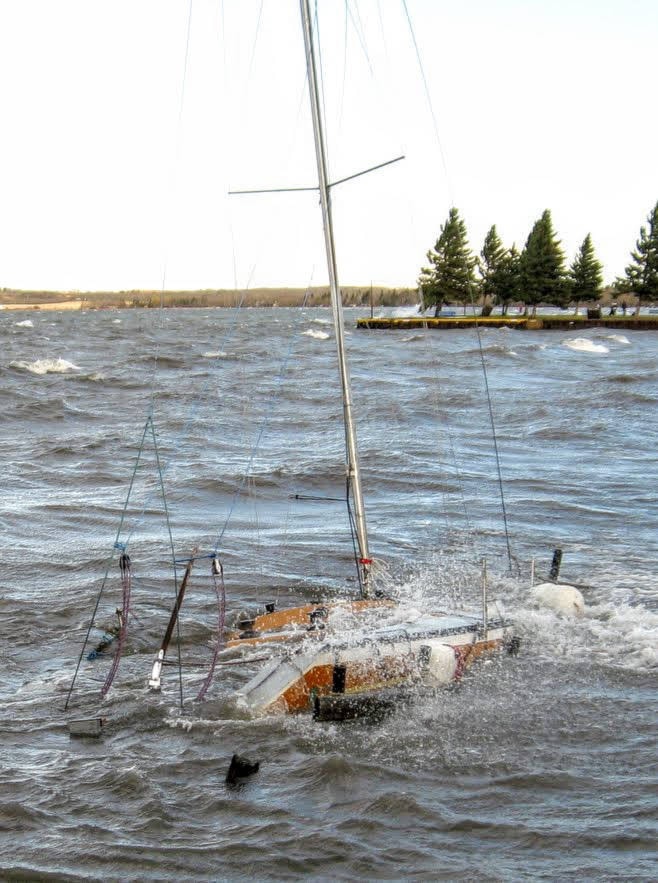Boating is fun. If only boaters could get access to the recreational lake with the best water quality in Central Alberta at Sylvan Lake.
Central Alberta’s last ice age of 14,000 years ago left watershed terrain that is unkind to boat launchers of today. Much of the shoreline topography conspires to reject siting and construction of more boat ramps. Private and public property in the Summer Villages, Town and Counties occupy the shoreline. Some road allowances, environmental reserves, the Natural Area, the camps, and the Provincial campground escarpment are off limits. The lake bottom labelled on maps with Protected Notations, identify habitat that is reserved for fish and waterfowl.
What’s left? A few locations that have been identified by land use consultants as potential boat launches have undesirable combinations of steep land slopes and shallow lake bottoms. Those watershed contours effectively say: “Go Away.” Fluctuating lake levels confound launch site plans. A one-foot drop in lake level can make potential sites unusable.
We have more studies about boat launches than actual ramps. Expensive reports in 2002, 2010 and 2015 all reached similar conclusions: There are no ideal sites. In addition, subsidies for day-use ramp projects are too expensive even for rich municipalities. The costs of boat launches and marinas challenge the boating community.
Each ramp study published similar maps of the environmentally sensitive, Protected Notation areas of the lake and surrounding shore. Reed beds, grasses and aquatic plants are signs that fish, birds and other wildlife live there too. Rules of respect of the lake advise high wake powerboaters to stay away. Chronic disturbance of those habitats with wave action, silt fluidization, and sound system noise are Worst Stewardship Practices. Fish and waterfowl are not into wakeboarding. The eagles prefer silence.
Power boaters do get what they pay for. Except for the free Lacombe County ramp, users get no amenities, or close to it. The sheltered Marina Bay and WatersEdge private marinas offer gated access, high quality slips, some marine facilities, and in one case limited hours of operation. Marina Bay includes a dredged harbor entrance self-funded by the homeowner association that illustrates the true cost of maintaining infrastructure for boating. Lake sediments are always on the move.
Costs and convenience have caused day-launchers to seek low-cost solutions. Power boating traffic has migrated to the Lacombe County ‘free’ boat launch at the NW end of Sylvan Lake, further exposing the most environmentally sensitive areas to adverse effects of recreational boating.
Can another boat launch facility be justified, even if the preferred site of the 2010 study could be funded? Let’s do the math: Assume 14 boating weeks from May to September, including 4 long weekends. That means about 100 days of which 12 are premium ones. Some will be wiped out by weather, so assume 10 premium days on which 100 power boaters will pay a launch fee of $75 (ramp income $75,000). Estimate that an average of 25 boaters will use 60 mid-weekdays at $50 (ramp income $75,000). Deduct operating costs of, say, $250,000, and the new launch ramp service will lose $100,000 a year before the front-end capital investment of several million dollars is repaid. Stewardship of both financial and environmental resources are boat launch prerequisites.
Boating on Sylvan Lake is not ‘free’. Slips in one private marina cost $2,500 for about 100 days of access during which 25 might be for boat-use. That is the benchmark price tag for the convenience of boating access to Sylvan Lake at a quality facility, although with minimal marina services.
In addition to cost and inconvenience, Sylvan Lake can be unkind to boaters. When weather systems drive strong northwest winds down the centerline of the lake, conditions send most recreational boaters back to safety. Ramps without breakwater security are fully exposed to storms and squalls. They create entertaining heavy-air haul-out scrambles.
The lake archives record these cases: Boats untied from docks have ended up as salvage on the Town beach; A moored yacht was holed and eventually drifted and sunk beside the old waterslide; A capsized powerboat towed into Marina Bay released its fuel inventory into the harbor water. None of those incidents is recommended as best stewardship or best seamanship practice. Marine risks lurk everywhere.
The same weather that creates hazards for boaters is beneficial as winds typically bring rain, the one currency that creates value for the watershed community. Experience shows that extreme weather systems with winds as low as 15 knots endanger flat-water craft, their operators and passengers. They can occur about twice a month and last for a couple of days. They clear the beach.
Responsible boaters can help stewardship and respect the lake by voluntarily operating in water deeper than 10 metres. Set the depth-sounder alarm. That lake area of 21 sq. km is about half of Sylvan Lake’s surface area of 42 sq. km. That considerate compromise would protect most fish and waterfowl habitat, reduce onshore noise, and ensure that 262 boaters could power around safely in their own eight hectares of recreational lake space.
For more on best stewardship practices, view https://slwss.org.
